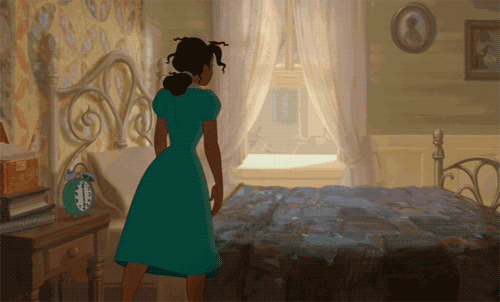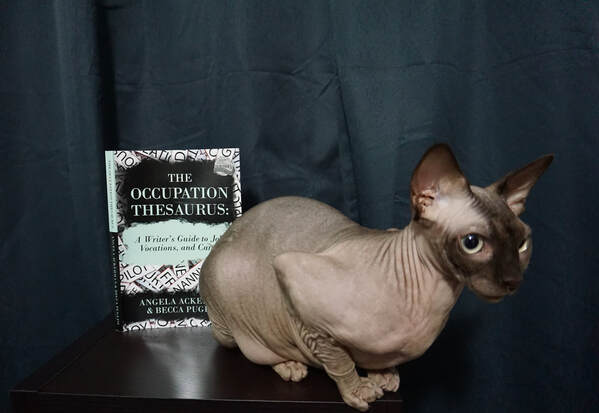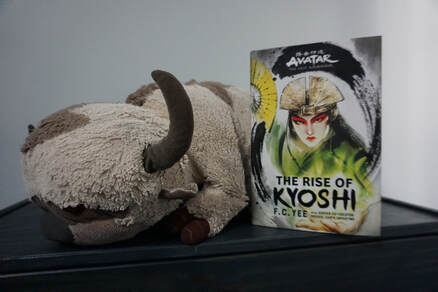|
Spent all week gathering and then acting on feedback for my piece for Futurescapes 2021. Finally clicked submit! It's been exhausting, but worth it. Gif is not my own, obviously.
0 Comments
White room syndrome haunts all writers. It’s when you have a scene with dialogue, maybe some internal narration, but almost nothing going on between the characters and their environment. They could be anywhere—literally a white room. And it’s not just a problem in writing, it happens in improv too. The actors are so focused on their back and forth that the audience has no idea of the context. For example, a conversation about how in love two people are has one context if it’s at a New Year’s Eve party, but a much weirder and more interesting context if it’s at a funeral.
The biggest cause of white room syndrome is that the immediate setting is boring. So boring that even you, the writer, have forgotten about it. My best experiences curing this problem have been changing up the environment, or at least adding to it. Here are four ways to change the setting to help you cure white room syndrome. Place your characters somewhere that reveals info about at least one character. It could be a bedroom full of family photos and travel mementos. Their kitchen, full of one-use infomercial tools. Their office with a single personal photo. Wherever you choose, make it significant and demonstrative of one character’s personality. That way, you remember to describe it throughout the scene, because it adds depth. Place your characters somewhere that has a lot of things to interact with. It could be a car, with the radio, A/C, windows, etc. It could be a child’s playroom with toys all over the floor like landmines. It can be as simple as a clothing store. Give your characters a variety of options for actions to take while they listen to or speak with each other. Think of conversations you have in real life; you’re almost always doing something with your hands. Place your characters somewhere that demands they pay attention. A scented candle store—can’t escape the smells. A very hot sauna—can’t ignore the heat. A spicy hot wing tasting plate at a restaurant—can’t eat that without feeling every bite. The environment then interacts with your character, rather than the character initiating contact first. This forces you to trickle in setting details throughout. Place your characters somewhere symbolic. If the conversation is about betrayal, they could be in an art museum in front of a painting of Judas. If the conversation is about forbidden love, they could be in the wine aisle and one bottle could be from a vineyard called Verona. If they’re discussing madness, maybe they’re on a walk and see some windmills (even modern wind turbines would probably be enough of a Quixote nod). You can be sneaky or overt with this, even suggesting how their plot will end. If you go into a scene planning to include a symbolic item or location, then you won’t forget to include it. Those are my tricks for making a white room transform into an actual setting. What tricks do you use? Did you try mine and like them? Let’s discuss in the comments! Clue's occupation is, of course, protector of the domain. Photo by Kate Ota 2021 Part of the same series of helpful thesauruses as The Emotion Thesaurus, The Occupation Thesaurus by Angela Ackerman and Becca Puglisi is exactly what it sounds like. I’m sure you were expecting an Is It Worth It post about it, but I loved The Emotion Thesaurus so much, I knew this would be worth it.
And it is! There’s information up front about different ways to help select your character’s job to best serve the plot or theme. There’s a section about the many reasons why anyone chooses any given job (including Maslow's Hierarchy of Needs, which made my nerdy little ex-high-school-debate self so happy). The back also has sections where you can create your own entry or work through the logic of choosing a job for your character. Incredibly helpful stuff! I decided that instead of just reviewing The Occupation Thesaurus, that I’d add my own entry here! This seems to be encouraged, as there are more careers on the authors’ website (here) and in One Stop for Writers (which I reviewed before.) Let’s get into the entry! I followed the same format as the book’s entries. Occupation: Zookeeper Overview: A zookeeper is a person who cares for various animals at a zoo. Depending on the size of the zoo, they may work in only one area (such as primates or African Mammals), or they may rotate through every section of the zoo. Duties include feeding, cleaning enclosures (both exhibits that guests see and behind-the-scenes housing), administering medication (as prescribed by the zoo vet), and providing enrichment (such as training or making new toys). Necessary Training: Usually a bachelor’s degree in some kind of animal or biology related field is required, although zookeeper internships exist for college students. Training is otherwise hands-on. Useful Skills, Talents, or Abilities: Being good with animals, public speaking, cleaning skills, kinetic memory, basic first aid, food prep Helpful Character Traits: Adaptable, adventurous, alert, calm, cautious, positive disposition, hard worker, morning person, caring, nature loving, compassionate, environmentally conscious Sources of Friction: Guests who misbehave or abuse the animals Being unable to help a sick or injured animal Being unable to breed a rare species Having to put down an animal Public backlash to putting down an animal Frustration when an exotic animal is kept as a pet Getting exceedingly messy early in the day and having to stay that way Animals making a giant mess Needing to fundraise Physical fatigue Being bitten or injured by an animal Being peed or pooped on by an animal Needing to protect new trainees/interns/volunteers from dangerous animals Having an animal dislike you and act out against you Early hours The fact that despite dangerous weather, the animals need care every day People They Might Interact With: Other zookeepers, vet techs, zoo vets, veterinary specialists, zoo guests, interns, wedding parties, other party guests, zoo director, famous animal advocates associated with their zoo, news media, animal rights groups, representatives from the Associate of Zoos and Aquariums (if US based), conservation program coordinators, breeding program coordinators, students How This Occupation Might Impact the Character’s Needs: Self-Actualization: A zookeeper may feel they are contributing to a meaningful goal of conservation. However, if a rare animal dies in their care, they may feel they are failing a meaningful goal. Esteem and Recognition: The zookeeper may seek recognition for handling s a problem in a species that other zoos or keepers struggled with. However, they may also loose confidence if an accident occurs. Love and Belonging: Zookeepers tend to bond together and have good camaraderie because of the hours and labor involved. However, long hours of lots of physical labor leaving the character exhausted may deteriorate personal relationships. Safety and Security: The job pays a living wage and zoos can be found in cities of all sizes. However, working with certain animals poses a danger to the keepers whether from venom, teeth, horns, allergies, or size. Characters Might Choose This Occupation Because They… Love animals Are concerned about climate change and the impact on species around the world Want to advocate for something/someone who cannot speak for itself Are compensating for a past wrong against animals Believe animals are better than people (due to a past emotional wound) Want to fight against poaching from a distance Want an adventurous sounding job, but to remain relatively stable Idolize a famous conservationist (ex. Steve Irwin) There are many occupations in the thesaurus, and many that aren’t! Check out their lists at writershelpingwriters.net and see for yourself. Got one they don’t have? Leave it in the comments! If you didn't already know, Small Great Things by Jodi Picoult is our next book on Judging More Than Just the Cover: Book Club. This week, I finished reading it. This book, as I’m sure we’ll discuss, was very hard to read, emotionally. I powered through and was over halfway on Wednesday, January 6th.
I read the section about the white supremacist who got angry and was trying to whip his friends into a mob and go on a violent rampage. Everyone the character contacted told him no. About an hour later, in real life, the Capitol was broken into by that mob of terrorists. Fictional white supremacists were more restrained than real ones. A fictional bailiff who towed a screaming character out of a courtroom did more to quell white supremacy than Capitol Police. I can’t really get over the juxtaposition of what I read and what happened. The coincidence of the timing. I’m sure it’ll come up on the podcast, which we’re recording later this month. If you’re still in a fragile place after Wednesday, put off reading Small Great Things for a little while, the majority of the book will only make you angry and anxious. There is resolution though, as any book requires, so if you’re in the thick of it now, push through. I bet you expected a cat photo. Surprise, it's Appa, a Christmas present from 2006 (or 2007?). Photo by Kate Ota 2020 I received The Rise of Kyoshi by F.C. Yee with Michael Dante DiMartino as a gift from my husband for Christmas. Like me, he loves Avatar: The Last Airbender, and insisted on reading it after I finished.
The book follows the early life of Avatar Kyoshi, the Earth Kingdom avatar two incarnations prior to the TV show’s protagonist, Aang. Kyoshi appeared on the show several times, each time being an absolute badass, and inspired the Kyoshi Warriors in their techniques and dress. Since I knew who Kyoshi would become, I wondered if author F.C. Yee would be able to surprise me. Positives: I loved the plot! A unique take that makes sense from what fans already know about Kyoshi and her mess-of-a-predecessor, Kuruk. There was expansion of the world in unique ways, but not so much that you wonder why some cool things didn’t exist in the show. (I call this is the Star Wars Prequel Problem, where the prequels offered a ton of new technology that somehow the audience is supposed to believe disappeared before the original trilogy.) The book pulled me through it, and I read over 100 pages each time I sat down with it because I absolutely needed to know what happened next. In fact, I’m about to read the sequel because it still has that pull. Negatives: I’m not sure I’d have noticed this if I wasn’t a writer, but there was a lot of head hopping. This is when, in the middle of a scene established as being from Character A’s perspective, you suddenly have a sentence or two in the point of view of Character B, and then back to Character A. This occurred at least once every chapter, and drove me a little insane. They weren’t necessary pieces of information for the reader. For example: “Character B realized Y and said, “dialogue that makes it clear he just realized Y.”” The head hopping is the phrase “Character B realized”—which the POV character, Character A, can’t know because she’s not in Character B’s head. And the dialogue, or sometimes action, of Character B would then make it clear what their internal thoughts had been, so I don’t know why these head hopping moments were included. Overall rating: 4.5/5 I loved the plot, creativity, and of course I’m a sucker for the avatar universe. Without the unnecessary and distracting head hopping, it would have been a perfect 5. I’d recommend this to any fans of Avatar: The Last Airbender. I believe it’s technically YA, as the protagonist is sixteen for most of the book, but adults will love it too. It may be less understandable or enjoyable for anyone who has never watched the original show, as there are many references to geography and world lore that are not independently explained. You may be able to get it if you’ve only seen the sequel TV series, The Legend of Korra. Are you a fan of Avatar: The Last Airbender? Have you read the Kyoshi series? How about all those graphic novels? Let’s discuss in the comments! |
Archives
April 2024
Categories
All
|





 RSS Feed
RSS Feed